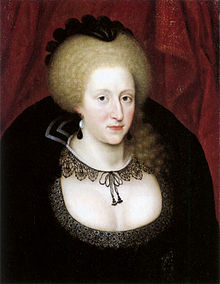Anne of Denmark
| Anne of Denmark | |
|---|---|

Portrait attributed to Marcus Gheeraerts the Younger, c. 1612
|
|
| Queen consort of Scots | |
| Tenure | 20 August 1589 – 2 March 1619 |
| Coronation | 17 May 1590 |
| Queen consort of England and Ireland | |
| Tenure | 24 March 1603 – 2 March 1619 |
| Coronation | 25 July 1603 |
| Born | 12 December 1574 Skanderborg Castle, Skanderborg, Denmark |
| Died | 2 March 1619 (aged 44) Hampton Court Palace |
| Burial | 13 May 1619 Westminster Abbey |
| Spouse | James VI & I (m. 1589) |
| Issue among others... |
|
| House | Oldenburg |
| Father | Frederick II of Denmark |
| Mother | Sophie of Mecklenburg-Güstrow |
Anne of Denmark (Danish: Anna; 12 December 1574 – 2 March 1619) was Queen consort of Scotland, England, and Ireland as the wife of King James VI and I.
The second daughter of King Frederick II of Denmark, Anne married James in 1589 at age 15 and bore him three children who survived infancy, including the future Charles I. She demonstrated an independent streak and a willingness to use factional Scottish politics in her conflicts with James over the custody of Prince Henry and his treatment of her friend Beatrix Ruthven. Anne appears to have loved James at first, but the couple gradually drifted and eventually lived apart, though mutual respect and a degree of affection survived.
In England, Anne shifted her energies from factional politics to patronage of the arts and constructed her own magnificent court, hosting one of the richest cultural salons in Europe. After 1612, she suffered sustained bouts of ill health and gradually withdrew from the centre of court life. Though she was reported to have been a Protestant at the time of her death, evidence suggests that she may have converted to Catholicism sometime in her life.
Historians have traditionally dismissed Anne as a lightweight queen, frivolous and self-indulgent. However, recent reappraisals acknowledge Anne's assertive independence and, in particular, her dynamic significance as a patron of the arts during the Jacobean age.
Anne was born on 12 December 1574 at the castle of Skanderborg on the Jutland Peninsula in the Kingdom of Denmark. Her birth came as a blow to her father, King Frederick II of Denmark, who was desperately hoping for a son. But her mother, Sophie of Mecklenburg-Güstrow, was only 17; three years later she did bear Frederick a son, the future Christian IV of Denmark.
...
Wikipedia
